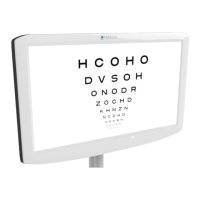The user must take into account the potentially harmful effects on the environment and human
health that could result from the non-compliant disposal of the instrument in its entirety or some of
its components.
To avoid the release of dangerous substances into the environment and to encourage the
preservation of natural resources, the manufacturer facilitates, in the event that the user wishes to
dispose of the instrument at the end of its lifespace, the reuse, recovery and recycling of the
instrument and its components. Before disposing of the instrument, the requirements of European
and national regulations must be taken into consideration.
Do not dispose of the instrument with household waste, but dispose of it separately by giving it in a
company specialized in the disposal of electrical and electronic equipment or at the local
administrative services in charge of waste collection.
The supplier or manufacturer is required to recover the old equipment.
By joining a consortium for the waste of technological equipment, the manufacturer covers the
treatment and recycling costs of the used instrument.
The manufacturer undertakes to provide the user with all the information relating to the dangerous
substances contained in the device and the methods of recycling these substances, and to inform
them of the existence of recycling of the used equipment. The law provides for severe penalties in
case of infringement.
3. Electromagnetic compatibility
All of the information listed below is based on normative requirements to which manufacturers of electro-
medical devices are subject, as defined in the IEC60601-1-2 Ed4 standard.
The device complies with the applicable electromagnetic compatibility standards, however, the user must
ensure that any electromagnetic interference does not create an additional risk, such as radio frequency
transmitters or other electronic devices.
In this chapter you will find information necessary to ensure that your device is installed and put into
service in the best conditions in terms of electromagnetic compatibility. The device's different cords must
be separated from each other.
Certain types of mobile telecommunications devices such as mobile phones may interfere with the device.
Recommended separation distances must therefore be respected.
The device shall not be used in the vicinity of or placed on another device. If this cannot be avoided, it is
necessary to check its proper functioning under the conditions of use before using it. The use of
accessories other than those specified or sold by the manufacturer as replacement parts may result in an
emissions increase or a decrease in the immunity of the device.
In case the device stop working, reset the device, restart test from the beginning, do not use the previous
data for make prescription.
a
. Length of cables, cords, etc.
The length of cables or cords must be greater than 3 meters.
Type of test In accordance with
RF emission CISPR 11, Class A
Harmonic current emission IEC 61000-3-2
Voltage fluctuations and flickering IEC 61000-3-2
Immunity to electrostatic discharge IEC 61000-4-2
Radiated Immunity - Electromagnetic Fields IEC 61000-4-3
Immune to electrical fast transients and bursts IEC 61000-4-4
Shock-wave immunity IEC 61000-4-5
Conducted radio frequency disturbance immunity IEC 61000-4-6
Radiated Immunity - Magnetic Fields IEC 61000-4-8
Immunity to voltage dips, brief cuts and voltage
variations
IEC 61000-4-11
USER MANUAL > CAUTIONS & WARNINGS
43 Vision-C 600 - Polarized visual chart system > V1- 02-2021 (VRSQSE)

